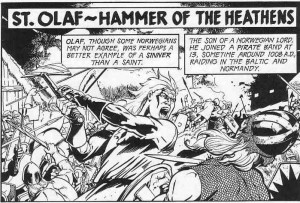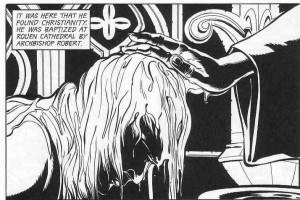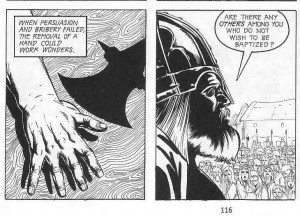I’m a lapsed Catholic who loves reading about the history of the Catholic Church. For the past few days I’ve been reading “The Big Book of Martyrs,” a comic written by John Wagner (creator of Judge Dredd) in collaboration with over two dozen artists. Back in the 90s, it was published as part of a series of reference-lite comics under the “Factoid Books” label. The comic consists of about 50 biographies of Christian martyrs (the vast majority Catholic, with a few Orthodox mixed in), each only about 3-4 pages. Needless to say, these snippets can provide only the barest details, but the brevity is also a blessing. Reading 50 full-length biographies would be a time-consuming chore, especially if they were all written in the dry, indifferent manner of a reference book.
While “The Big Book of Martyrs” could never be seriously compared to a scholarly work of history, it did at least inspire me to do further research on a few obscure martyrs that I had never heard of before. And for all its limitations, the book serves as an adequate introduction to Christian martyrs, and the comic format makes it a quick and accessible read.
But I don’t intend to write a full review of the comic, at least not for this week. I’d rather talk about one of the more entertaining martyrs, St. Olaf of Norway (995 to 1030 AD).
Artwork by Rafael Kayanan
Olaf started his life as a Viking, and I mean that literally. His early career was as a pirate and later a mercenary for the Duke of Normandy. And it was in Normandy that Olaf converted to Christianity.
Like many new converts, Olaf was a zealot. He was also ambitious, and he eventually subdued the petty “kings” of Norway, drove out the Danes, and declared himself the sole King of Norway in 1015. And the first thing the new king did was initiate a policy of mass conversion. And since he was a Viking-zealot, mass conversion included cutting off hands.
Converting much of Norway to Christianity also reinforced royal authority. The Norwegian Church was dependent on the patronage and protection of the king, and in turn the Church supported the king’s claim of absolute power. But Olaf was making enemies, and the Norwegian nobility backed an invasion by King Cnut of Denmark (also a Christian). Olaf fled to Russia, but eventually he returned to reclaim his throne. Olaf was killed (or “martyred,” if you’re feeling charitable) at the Battle of Stiklestad in 1030.
Olaf’s death had arguably less to due with his religion than with the power politics of medieval Scandinavia. But he was beloved by the Norwegian clergy, who canonized Olaf within a year (at the time, canonization was not a formalized process). Sainthood generally requires two miracles, but Olaf had at least four alleged miracles associated with his death: his body was bathed in light at night, a blind man regained his sight by dipping his fingers into Olaf’s blood and rubbing his eyes, his corpse showed no signs of decay for over a year, and a spring with miraculous healing properties emerged from where Olaf’s body fell. Moreover, as Danish rule grew increasingly unpopular, Olaf became a symbol of Norwegian independence. Thus, the brutal tyrant was re-branded as a martyr and national hero.
But most martyrs were not bloodthirsty Vikings. And a few actually seemed like nice people. I’ll review some of their entries next week.




Good one, Richard! I think more should be written about the ‘Big Books’series.
Besides their intrinsic worth, they were a great gig for a lot of alternative cartoonists; I bet they paid the overdue rent more than once! And a great place to stretch your wings (and pocket some welcome extra change) for mainstream artists.
Look forward to future installments…
I’ll talk more about the cartoonists next week, I think. Rafael Kayanan’s art is rather boring and functional, so there isn’t much to say about it.
But several of the artistic contributions are less mainstream, which leads to some interesting intrepretations.